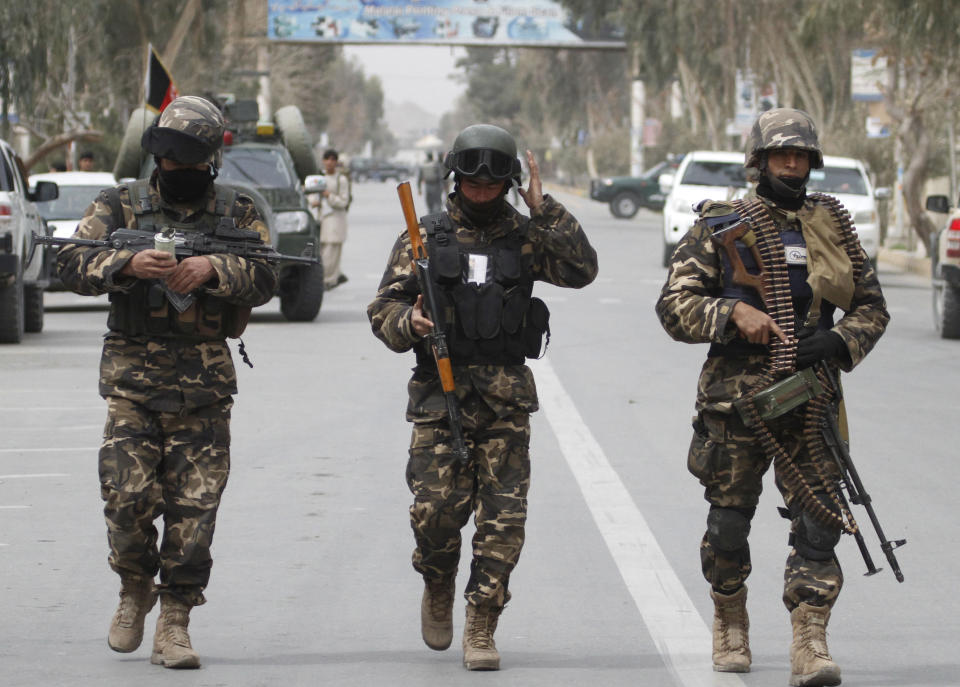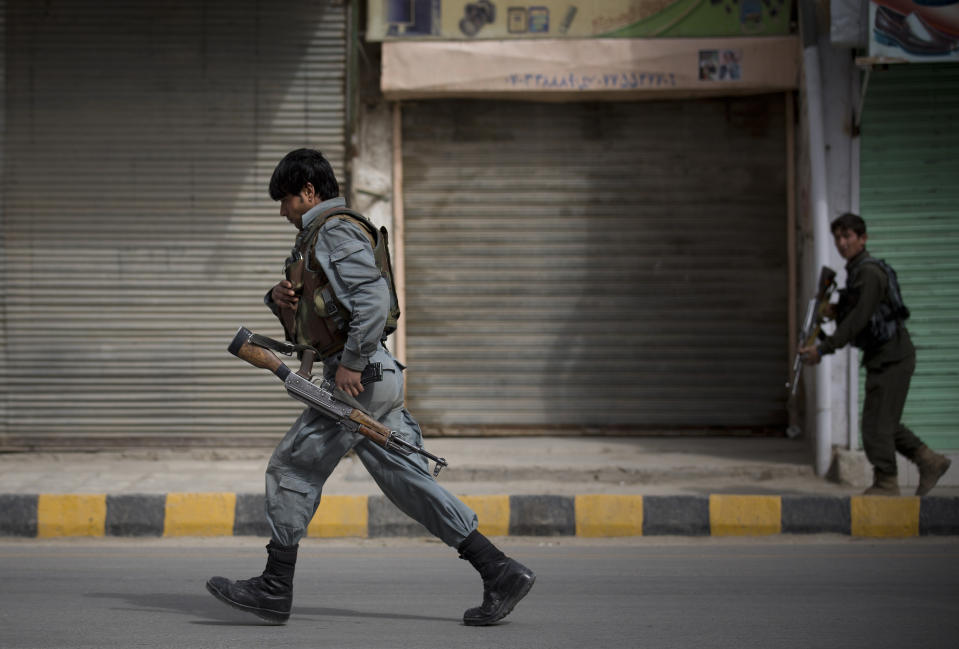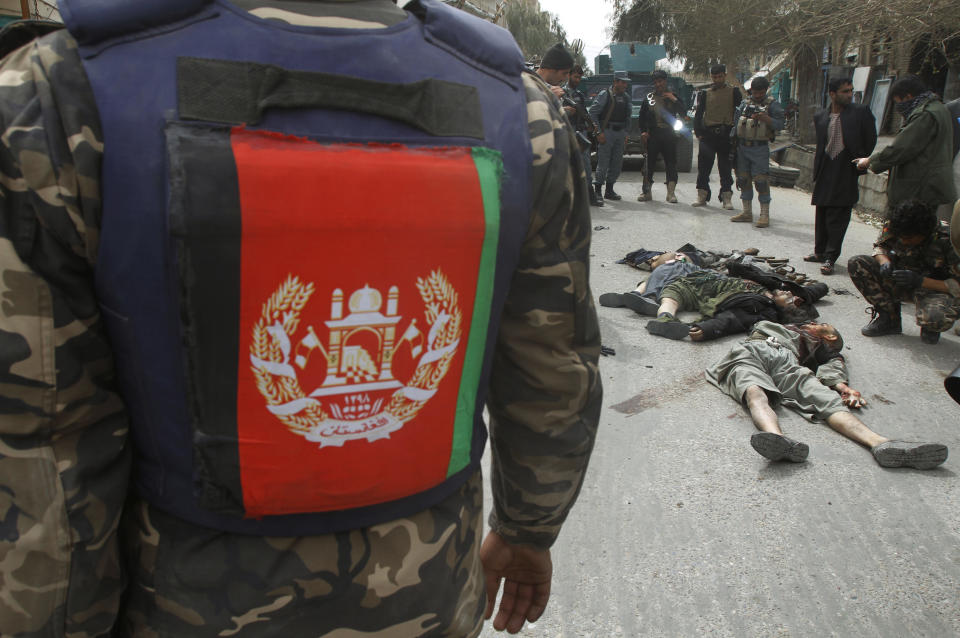Afghan forces kill 3 attackers in battle in south
KANDAHAR, Afghanistan (AP) — It began with a rattle of gunfire when insurgents attacked a former intelligence headquarters in this southern Afghan city. For more than an hour Wednesday, automatic weapons and machine gun fire resounded as police and commandos hunted down the three attackers.
The battle, witnessed by The Associated Press, provided a rare firsthand glimpse of Afghan security forces in action without international support. The troops showed some weaknesses — lack of equipment and glitches in coordination — but eventually emerged victorious, killing the insurgents.
The Taliban claimed responsibility for the attack, which showed the sort of daily tests Afghan forces have faced since taking the lead in security duties while U.S. and allied combat troops prepare to withdraw by the end of the year. The Islamic militant movement has stepped up its campaign of violence ahead of April 5 presidential elections.
Kandahar is the birthplace of the Taliban movement, which held power in Afghanistan for five years until it was ousted in a 2001 U.S.-led invasion following the 9/11 terror attacks in the United States. It has been the site of some of the deadliest battles between insurgents and international troops, but Afghan forces have assumed responsibility for securing the area and only receive help from NATO forces when they request it.
Washington has said it will likely refuse to leave behind a residual U.S. force of several thousand troops to train and mentor Afghanistan's security forces if the Afghan government does not sign a bilateral security agreement with the U.S. by the end of the year.
Wednesday's attack began with what appeared to be a mistake by the Taliban. The building they struck was abandoned by the intelligence agency several months ago when it moved its headquarters to a nearby location. Only a skeleton crew of guards was there on Wednesday.
"They must not have known that the intelligence headquarters had relocated," deputy police chief Rehmatullah Atrafi told the AP after the battle.
The three attackers — young men in their early 20s wielding hand grenades, automatic rifles and smaller weapons — opened fire on the building at about 11 a.m., forcing the guards to retreat inside. The insurgents then moved onto nearby rooftops.
The police response was quick. Officers rushed to the site from a nearby station in green armored pickup trucks and cordoned off the road. They had bullet-proof vests, but notably no helmets. They were followed by police armored vehicles mounted with machine guns that fanned across nearby streets, searching for the attackers.
Soon after, intelligence service commandos moved in. They were equipped with considerably better body armor and had helmets — along with scarves wrapped around their faces to protect their identities. They rode in Humvees, instead of the pickup trucks used by police.
One insurgent was gunned down early in the fight, but the two others held out as the security forces raced through the streets, a constant sputter of automatic gunfire reverberating through the area.
Two AP journalists witnessed the gun battle along with several Afghan reporters from behind the cordon a few hundred yards (meters) from the former intelligence building.
At one point, chaos erupted. It appeared that one insurgent had managed to flee into surrounding streets and was on the loose. The police — speaking rapidly on their walkie-talkies — weren't sure. Several ran down a main road looking toward the rooftops. Some ducked as they ran, fearing they could be hit from above.
Amid the confused battle, communication appeared to be shaky at times. Despite the walkie-talkies, police cordoning off the roads were not sure what was going on in the thick of the shooting a short distance away.
At one point, police Col. Mohammed Omar looked surprised to see his men retreat away from the site of the gun battle. He moved for cover, not sure what turn the battle had taken. Talking rapidly into his walkie-talkie, he received word that an insurgent might be nearby, maybe on a nearby rooftop.
Then a powerful boom from a heavy machine gun sounded from the area of the former intelligence headquarters, followed by automatic weapons fire. The remaining two insurgents were trapped, police said.
Finally, the machine gun fire stopped. Policemen slowly walked away from the site. It was over.
The mangled corpses of the insurgents were left on the street and displayed to journalists for about an hour before being taken away in a police pickup truck. One commando and a woman who lived in the area were wounded in the fight, police said.
One policeman bent down and fixed one slain insurgent's baggy pants, not wanting his body to be exposed. One attacker had been shot in the neck, another in the head. Lying on top of one insurgent's body were blood-soaked rupee notes from neighboring Pakistan.
In Kandahar, Pakistani currency is used as frequently as Afghan currency because of the regular trade between the two countries. But Afghanistan also routinely accuses Pakistan of harboring Taliban insurgents and giving them sanctuary to regroup and plot attacks on Afghan government facilities.
In a Pashtu language text message received by the AP, Taliban spokesman Qari Yusuf claimed responsibility for the attack and maintained the group's young fighters had killed four intelligence commandos and five policemen, a claim denied by the police.
Deputy police chief Atrafi said the attackers had slipped into Kandahar unnoticed in a white sedan.
"These young boys don't know any better. They can easily be manipulated into carrying out a suicidal attack like this one," he said.
___
Associated Press writer Mirwais Khan contributed to this report.
___
Kathy Gannon is AP Special Regional Correspondent for Afghanistan and Pakistan and can be followed at www.twitter.com/kathygannon









